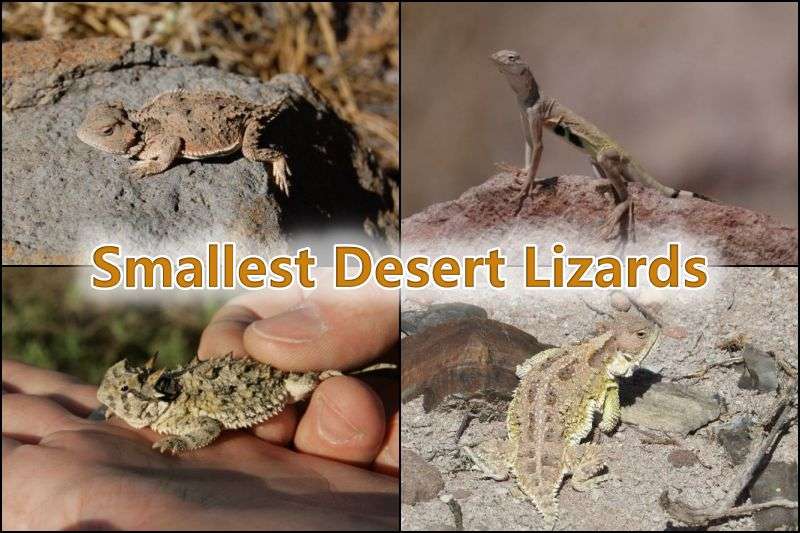Today we have a fascinating article on the smallest desert lizards. Lizards are quite unique reptiles in their own ways and are found in almost every kind of habitat, even in dry and hot deserts, which is the main focus of this article, other than their smaller size.
We may picture a desert, but surprisingly, deserts are quite diverse in their features and have all the necessary things to support life smoothly, including vegetation of xeric plants, predominantly different species of cactus.
So, various reptiles can be found crawling on sandy grounds or dunes in deserts, including different varieties of lizards, but this article focuses on the top 10 smallest lizards found in desert habitats.
Top 10 Smallest Desert Lizards in the World
10) Texas Banded Gecko
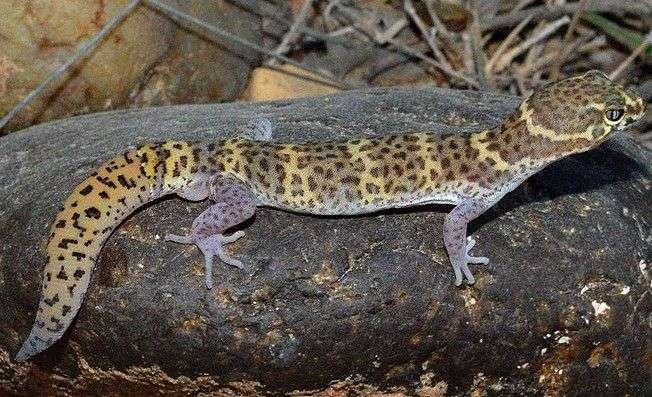
|
Scientific Name |
Coleonyx brevis |
|
Size |
10 cm (4 in) |
|
Life Span |
15 years |
|
Location |
The southwestern United States and northern Mexico. |
|
Diet |
Arthropods, including insects, spiders, mites, etc. |
Texas banded geckos are small, nocturnal geckos that reside in deserts and xeric shrublands in North America.
They have interesting patterns of alternating yellow and brown bands, with the yellow or tan bands narrower than the brown bands.
These boldly coloured geckos also have blotches on their backs and black outlines on their vividly coloured bands.
Additionally, they make good pets because of their human-friendly nature.
It would be surprising to note that they are capable of vocalization and are sometimes found to make squeaky noises when handled or harassed.
Although small, these creatures lay huge eggs in comparison to their bodies.
9) Desert Horned Lizard
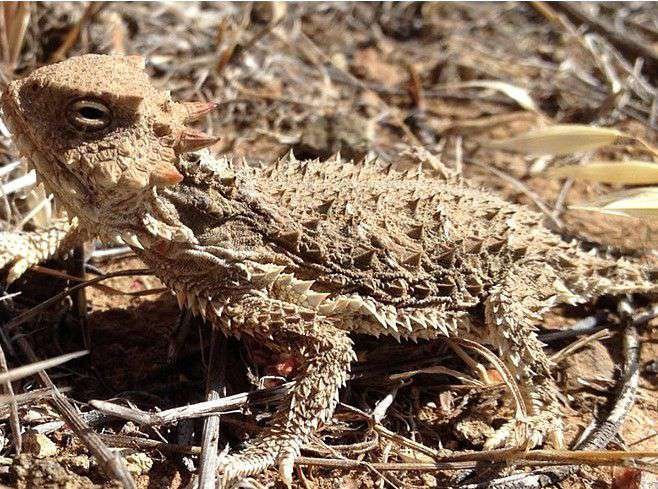
|
Scientific Name |
Phrynosoma platyrhinos |
|
Size |
9.5 cm (3.75 in) |
|
Life Span |
Up to 5 years. |
|
Location |
Western North America |
|
Diet |
Invertebrates, such as crickets, grasshoppers, beetles, ants, worms, flies, ladybugs, mealworms and some plant matter. |
Desert horned lizards are a type of horned lizard that is primarily found in xeric shrublands and areas of fine sand, but they are also distributed in extremely diverse habitats.
They are small lizards that are generally referred to as “horny toads,” despite being lizards, because of their toad-like appearance.
To illustrate, they bear huge pointed scales that are present ozn the back of their heads, which look like horns, as well as scattered pointed scales with dark blotches on the back of their bodies.
Moreover, they are flat and broader, which makes them different from other lizards. They have beige or tan bodies to blend in with the surrounding sandy grounds.
It is interesting to note that they display special rain-harvesting behavior by adopting a specific posture, and in general, they show a wide variety of displays, such as versatile tail-positions, push-ups, and even a three-legged stance during the mating time or for recognition.
8) Texas Horned Lizard

|
Scientific Name |
Phrynosoma cornutum |
|
Size |
9-13 cm (3.5-5 inches) |
|
Life Span |
Up to 5 years |
|
Location |
South-central regions of the United States and northeastern Mexico. |
|
Diet |
Harvester ants primarily, and beetles, termites, and grasshoppers, occasionally. |
Next on the list of smallest desert lizards is another horned lizard, the Texas Horned Lizard.
Texas Horned Lizards have spikey bodies, horns or spikes similar to those of other horned lizards, a blunt snout, and a rounded body.
They are distinguished by two large horns crowning the backs of their heads and a row of spikes on the lateral parts of their torso and the dorsal ridges of their backs.
Sexual dimorphism is present, with females being larger than males, and their coloration depends upon the environment they live in and could be yellow, brown, or tan.
Texas Horned Lizards are unique in the sense that they can literally squirt blood from the corner of their eyes up to five feet in a stream as defensive behavior, and this blood is generally foul-tasting to their predators, which might be dogs or wolves, and leaves them confused.
The most important thing about them is that they are the state reptile of Texas and the mascot of Texas Christian University.
7) Zebra-tailed Lizard

|
Scientific Name |
Callisaurus draconoides |
|
Size |
6.4-10.2 cm (2.5-4 in) |
|
Life Span |
1-4 years |
|
Location |
Northwestern Mexico and Southwestern United States. |
|
Diet |
Insects, spiders, and other small lizards. |
Zebra-tailed lizards are terrestrial lizards that prefer deserts or semi-arid regions with sparse vegetation and hard-packed soil, and they can withstand a wide range of temperatures and rainfall.
These lizards are flat-bodied, have relatively long limbs, and appear to be muscular.
To point out, they have various types of marking on their dorsum, but dominantly they have a reticulated pattern on their back and banding on their tails just like striped-pattern of zebra, hence named as Zebra-tailed lizards.
While females have an orange to yellow colour on their flanks during breeding seasons, adult males have two to three dark black stripes on their flanks that extend somewhat onto their bellies.
Furthermore, when threatened, they exhibit a variety of displays and puff up their bodies to expose their stripes.
6) Common side-blotched Lizard

|
Scientific Name |
Uta stansburiana |
|
Size |
6 cm (2.4 inches) |
|
Life Span |
1 year |
|
Location |
Western United States and northern Mexico. |
|
Diet |
All kinds of arthropods. |
Common Side-blotched Lizards got their name because of a black blotch marked behind their hind limbs on the flanks. These lizards are brownish black and grey and have speckled patterns of tan, brown, or black on the dorsum, coupled with cream-colored undersides.
During the breeding season, males develop brightly coloured spots on their backs, tails, and the tops of their hind limbs, which is also a distinguishing feature of males.
Moreover, they may develop clearly visible orange, yellow, or blue throats during breeding season.
The orange-throated males are known to be ultra-dominant because they have higher testosterone levels and dominate the areas that carry larger numbers of females and establish bigger territories.
You might be amazed by the cool fact that they use a game that resembles “rock-paper-scissors” as a competitive strategy to compete for mating, and males also tend to trick other suitors into believing that they are females.
5) Shovel-snouted lizard
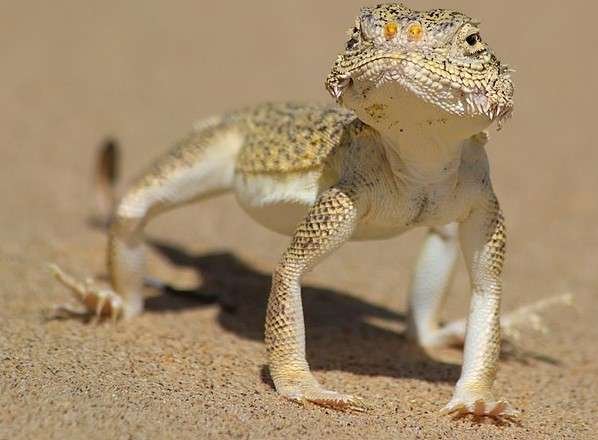
|
Scientific Name |
Meroles anchietae |
|
Size |
5 cm (2.0 in) |
|
Life Span |
3-5 years |
|
Location |
Southern Africa |
|
Diet |
Insects, especially small beetles. |
Shovel-snouted lizards are also commonly called Anchieta’s desert lizards, Namib sand-divers, and Anchieta’s dune lizards.
But their most common name comes from their unusual feature of a flattened snout coupled with a cutting edge and upward-pointing nostrils that they use as a shovel to dash across the sand rapidly without descending into the dunes.
They have unusually large fingers and do a “thermal dance” to protect themselves from overheating in soaring temperatures by lifting two diagonal limbs alternately every 10 seconds and balancing on their tails.
Additionally, they have paler, shimmery, sand-colored skin that is marked with black spots.
Above all, they can store a large amount of water in their special water bladder.
4) Greater Short-horned Lizard
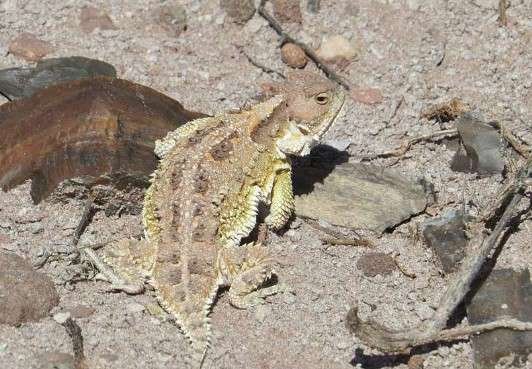
|
Scientific Name |
Phrynosoma hernandesi |
|
Size |
5-12 cm (2-5 in) |
|
Life Span |
Up to 5 years |
|
Location |
Western North America |
|
Diet |
Ants, beetles, and grasshoppers. |
Next, we have one more type of horned lizard, the greater short-horned lizard.
These are heavy-bodied, horned lizards that have a large number of small, pointed scales or spikes on their almost rounded bodies.
It is important to mention that they are often confused with pygmy short-horned lizards due to similar markings and features.
But they have a crown of spikes on the back side of their heads and distinctive rows of scales adorning the edges of their bodies, coupled with two rows of black spots extending till the back of their tails.
In terms of predation, they are sit-and-wait predators and are often found dwelling in areas with nests or trails.
They largely rely on their camouflage abilities to avoid predators, but they can also squirt foul-tasting blood from their eyes and confuse their prey using these tactics.
3) Sagebrush Lizard
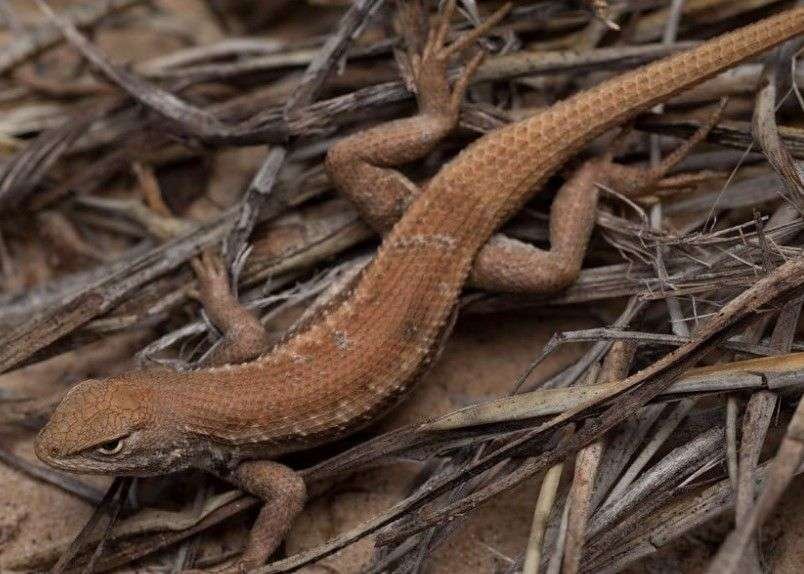
|
Scientific Name |
Sceloporus graciosus |
|
Size |
4.7–8.9 cm (1.9–3.5 in) |
|
Life Span |
1-2 years |
|
Location |
Western United States |
|
Diet |
Wide variety of bugs, ants, beetles, flies, spiders, etc. |
Sagebrush lizards and sagebrush swifts are diurnal and solitary creatures that bask in the morning as well as in the late afternoons and hunt in the daylight. As dusk approaches, they move into their shelters, which are underground burrows or under debris.
They are very small and have numerous scales on their bodies. They have a somewhat similar appearance to fence lizards; their gray, brown, or olive-coloured body is covered in dark-colored scales with irregular banding patterns on their body and tail.
In addition to their banding patterns, they have two conspicuous black bars on their shoulders.
It is interesting to note that they are easily frightened, and if any threat approaches, they become completely still and play dead.
These lizards are polygamous, but courtship is very expensive for these creatures, which exposes males to intense competition and predatory behaviors.
2) Pygmy short horned lizard

|
Scientific Name |
Phrynosoma douglasii |
|
Size |
3.2–6.4 cm (1.25-2.5 inch) |
|
Life Span |
Up to 5 years |
|
Location |
Northwestern United States and Southwestern Canada. |
|
Diet |
Ants, beetles, sowbugs, spiders, and caterpillars. |
Pygmy short-horned lizards are small horned lizards that are another species of “horned toad lizard” or “horny toad.”
They are adapted for very low temperatures and can reach such geographical areas where most other reptiles cannot.
These lizards are flat-bodied, stout lizards with snub noses and short legs, and they have spikes crowning their heads.
Spines are also present all over their bodies, in rows on their back pointing upwards, and have smooth scales.
They exhibit a vivid variety of colors, patterns, and sizes in comparison to other short-horned lizards and become more intensely colored when threatened or in aggressive mode.
1) Western clawless gecko

|
Scientific Name |
Crenadactylus ocellatus |
|
Size |
3.5 cm (1.8 in) |
|
Life Span |
Up to 8 years |
|
Location |
Western Australia |
|
Diet |
Small and large insects, including ants, moths, beetles, termites, and crickets. |
Lastly, we have the smallest lizards that are found in xeric or desert habitat, known as western clawless geckos, which are endemic to Australia.
They are terrestrial, ground-dwelling lizards that dwell in leaf litter, underground rocks, and rubbish piles.
Unquestionably, they are known for their clawless feature—they lack claws at the ends of their toes.
The coloration of these lizards depends on the habitat they reside in and may be black or brown with spotted markings and variable patterns in grey or brown.
Narrow stripes of slightly different colours are also present on their dorsum, along with a big, solid black, stout tail.
Conclusion:
Desert lizards have various modifications and adaptations to live in extreme desert conditions, such as long claws and thick scales to overcome water loss. Desert lizards live in rocky areas with sparse vegetation and in other conditions too.
If you want to identify any desert lizards, look for features such as pointed spines like scales and flat bodies. Here, we conclude this article. We hope you like it. You can give your suggestions in the comment box below.
References:
Wikipedia, Britannica, and National Geographic.
Also Read:

Hey there! I’ve been the kid who used to love watching all the science stuff and that fascination lead me to choose Zoology as my Major in Graduation. I’m a self-taught writer and spend my time writing scintillating content on animals. I love observing animals behavior and their bond with humans. I want to give my point of view regarding animals i research about. I had done several projects on animals during my graduation and learned their behavior thoroughly.
